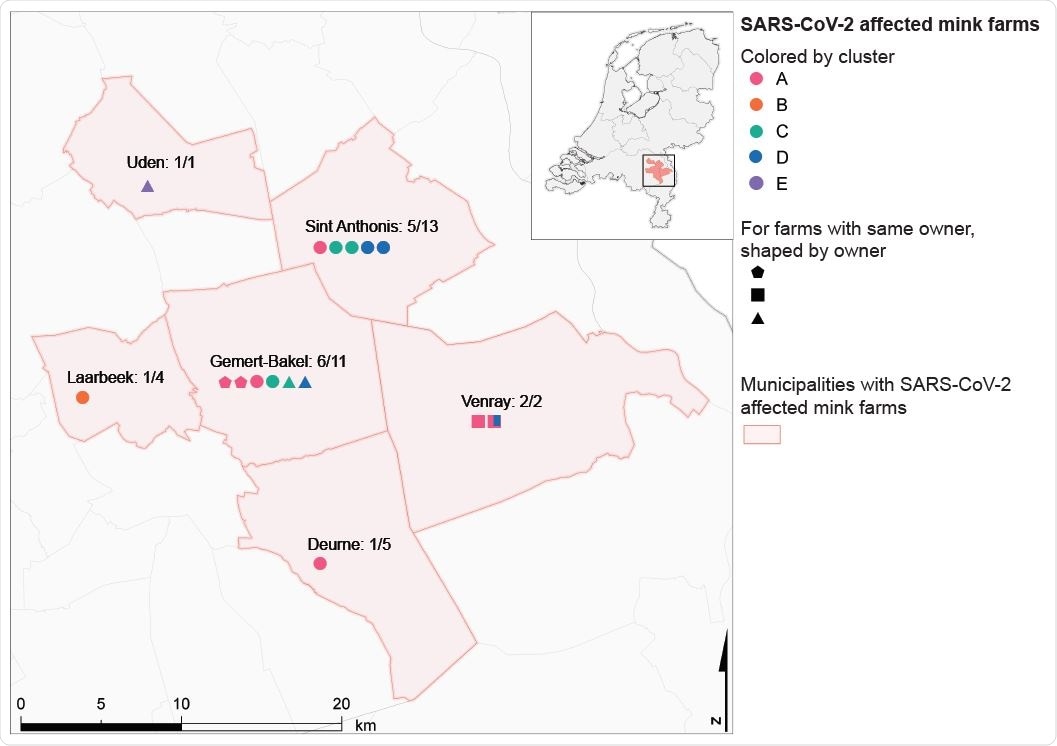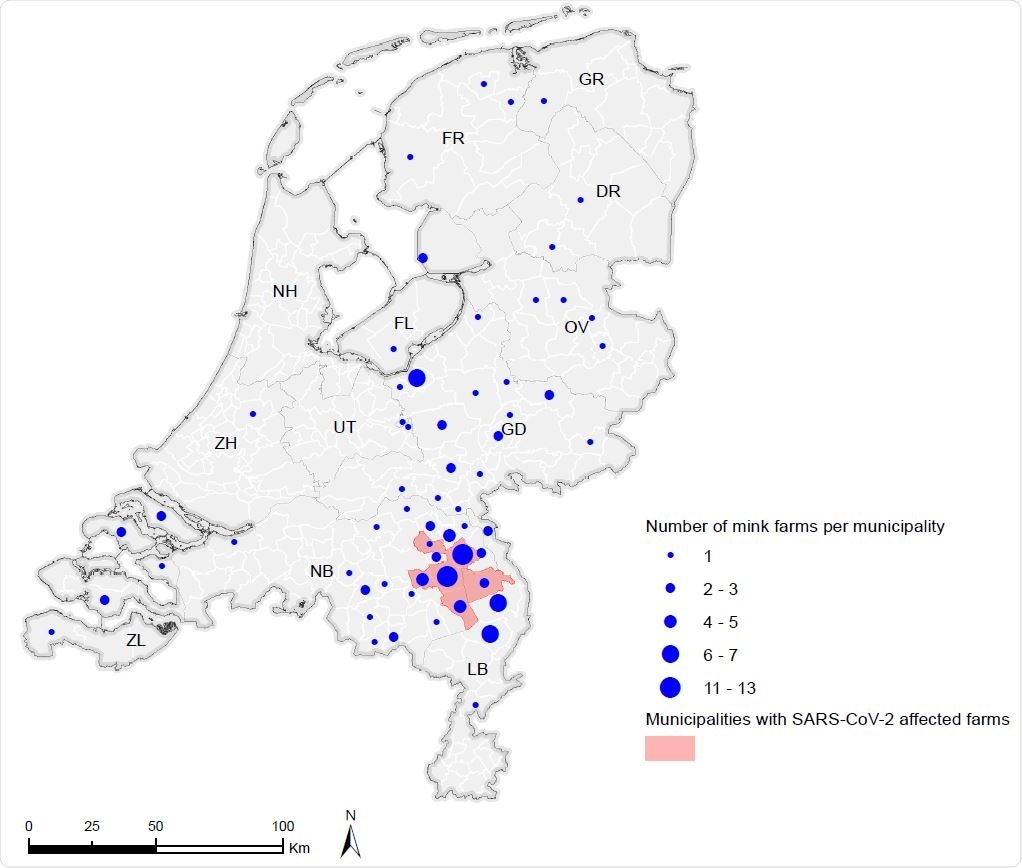An in-depth investigation of the severe acute respiratory syndrome coronavirus 2 (SARS-CoV-2) outbreaks on 16 mink farms by researchers from the Netherlands revealed that minks might serve as a reservoir for persistent infection in humans. The study is currently available on bioRxiv* preprint server.
The zoonotic origin of the coronavirus disease pandemic (COVID-19), caused by the SARS-CoV-2, is thus far unknown. Animal experiments have demonstrated that non-human primates, ferrets, cats, rabbits, hamsters and bats can be infected by this virus.
A recent introduction to this menagerie is the farmed mink. More specifically, infections in minks were observed in several farms in the Netherlands, while inhalable dust particles in the air of the mink houses were found to harbor SARS-CoV-2 genetic material.
The virus was initially diagnosed on two mink farms in the Netherlands on Apr 23 and Apr 25, 2020. After the initial detection of the virus on these farms, an in-depth investigation was initiated to look for potential transmission routes and to conduct an occupational and environmental risk assessment.
In this new study, Dutch researchers from a range of institutions conducted an in-depth investigation into the SARS-CoV-2 outbreak in mink farms and mink farm employees in the Netherlands, combining surveillance data, epidemiological information, and whole-genome sequencing on the human-animal interface.

Geographical overview of SARS-CoV-2 positive mink farms per municipality affected. The proportion of SARS-CoV-2 positive mink farms over the total number of mink farms (CBS, 2019) is indicated. Symbols for positive farms are colored by cluster and shapes indicate farms with a same owner.
From initial detection to whole-genome sequencing
Farm owners at the 16 mink farms positive for SARS-CoV-2 were contacted by the municipal health services in order to conduct the investigation, and their samples were taken for reverse transcription-polymerase chain reaction (RT-PCR) and serological diagnostics.
The researchers selected all available near full-length Dutch SARS-CoV-2 genomes in the national database that was available on Jul 1, 2020 (1,775 in total) and aligned with the sequences obtained in this study by using MUSCLE (multiple sequence comparison by log-expectation).
Additionally, to discriminate between mink farm-related SARS-CoV-2 infection and locally acquired ones, as well as to ascertain the potential risk for people residing in the proximity of mink farms, whole-genome sequencing was also performed on 34 SARS-CoV-2 positive samples from people who live in the same postal code area concerning the first four mink farms.
High sequence diversity of SARS-CoV-2 genomes
This study clearly shows an ongoing SARS-CoV-2 transmission in mink farms, but also pinpoints specific spill-over events to humans. A total of 68% of the tested farmworkers, their relatives, or contacts were shown to be infected with the virus – implying that the contact with SARS-CoV-2-infected mink represents a risk factor for contracting COVID-19.
Moreover, phylogenetic analysis of the mink SARS-CoV-2 genomes revealed that mink sequences of 16 farms could be grouped into five different clusters. There were no obvious distinctions in the presentation of disease in animals or humans between clusters based on the currently available data.
However, high diversity in the sequences from some mink farms has been observed, likely due to many generations of infected animals before a mortality surge, but possibly also as a result of already circulating virus in specific mink farms.
Animal surveillance as a prerogative
"To the best of our knowledge, these are the first animal to human SARS-CoV-2 transmission events documented", say study authors. "More research in minks and other mustelid species, to demonstrate if these species can be a true reservoir of SARS-CoV-2 although from our observations we consider this likely", they add.
Following the observations from this study, SARS-CoV-2 infections have also been unveiled in mink farms in Spain, Denmark, and the United States. Furthermore, it is important to emphasize that mink farming is also pervasive in other regions of the world, especially in China, where approximately 26 million mink pelts are produced every year.
"At the moment, despite enhanced biosecurity, early warning surveillance and immediate culling of infected farms, there is an ongoing transmission between mink farms with three big transmission clusters with unknown modes of transmission," highlight study authors in this bioRxiv study.
In conclusion, the structure and population size of mink farms open the door for sustained circulation of SARS-CoV-2 after its initial introduction. Hence, careful monitoring and collaboration between human and animal health services/experts remain pivotal for preventing the animals from serving as a reservoir for continued human infection.

Number of mink farms per municipality in the Netherlands. Overview of the total number of mink farms per municipality (CBS, 2019). Municipalities with SARS-CoV-2 affected farms by June 21st 2020 are shown in red.

 This news article was a review of a preliminary scientific report that had not undergone peer-review at the time of publication. Since its initial publication, the scientific report has now been peer reviewed and accepted for publication in a Scientific Journal. Links to the preliminary and peer-reviewed reports are available in the Sources section at the bottom of this article. View Sources
This news article was a review of a preliminary scientific report that had not undergone peer-review at the time of publication. Since its initial publication, the scientific report has now been peer reviewed and accepted for publication in a Scientific Journal. Links to the preliminary and peer-reviewed reports are available in the Sources section at the bottom of this article. View Sources
Journal references:
- Preliminary scientific report.
Oude Munnik, B.B. et al. (2020). Jumping back and forth: anthropozoonotic and zoonotic transmission of SARS-CoV-2 on mink farms. bioRxiv. https://doi.org/10.1101/2020.09.01.277152.
- Peer reviewed and published scientific report.
Munnink, B. B. O., Sikkema, R. S., Nieuwenhuijse, D. F., Molenaar, R. J., Munger, E., Molenkamp, R., Spek, A. van der, Tolsma, P., Rietveld, A., Brouwer, M., Bouwmeester-Vincken, N., Harders, F., Honing, R. H. der, Wegdam-Blans, M. C. A., Bouwstra, R. J., GeurtsvanKessel, C., Eijk, A. A. van der, Velkers, F. C., Smit, L. A. M., & Stegeman, A. (2020). Transmission of SARS-CoV-2 on mink farms between humans and mink and back to humans. Science, 371(6525). https://doi.org/10.1126/science.abe5901. https://www.science.org/doi/10.1126/science.abe5901.